Articles
- Page Path
- HOME > J Korean Acad Nurs > Volume 39(1); 2009 > Article
-
Original Article
- Effects of Listening to Music on Auditory Hallucination and Psychiatric Symptoms in People with Schizophrenia
- Hyun-Joo Na, Soo Yang
-
Journal of Korean Academy of Nursing 2009;39(1):62-71.
DOI: https://doi.org/10.4040/jkan.2009.39.1.62
Published online: February 28, 2009
1Research Assistant, College of Nursing, The Catholic University of Korea, Seoul, Korea.
2Professor, College of Nursing, The Catholic University of Korea, Seoul, Korea.
- Address reprint requests to: Yang, Soo. College of Nursing, The Catholic University of Korea, 505 Banpo-dong, Seocho-gu, Seoul 137-701, Korea. Tel: 82-2-590-1290, Fax: 82-2-590-1297, sooy@catholic.ac.kr
Copyright © 2009 Korean Society of Nursing Science
Abstract
-
Purpose
- The purpose of this study was to explore the effects of listening to music in inpatients diagnosed with schizophrenia, on their auditory hallucinations, and positive and negative symptoms.
-
Methods
- A quasi-experimental research design with 2×2 cross-over trial and convenience sample was used. Eleven patients (Group AB) listened to music followed by a wash out period and then a usual care period, and 12 patients (Group BA) had a usual care period followed by a wash out period and then listened to music. For one week those who were in the experimental period listened to individualized music using an MP3 player whenever they heard hallucinations.
-
Results
- There was a statistically significant decrease in the frequency of auditory hallucinations after listening to the music. There was a decrease in the mean scores for positive symptoms, negative symptoms, and general psychopathology after listening to music, but only negative symptoms showed a statistically significant decrease. The treatment effects on scores for positive symptoms, negative symptoms, and general psychopathology were greater in Group BA than Group AB.
-
Conclusion
- These findings suggest that listening to music may be useful for managing auditory hallucinations in schizophrenia inpatients.
- 1. Allen HA, Halperin J, Friend R. Removal and diversion tactics and the control of auditory hallucinations. Behaviour Research and Therapy. 1985;23:601–605.ArticlePubMed
- 2. American Psychiatric Association. Diagnostic and statistical manual of mental disorders. 1994;4th ed. Washington DC, APA Press.
- 3. Buccheri R, Trygstad L, Kanas N, Waldron B, Dowling G. Auditory hallucinations in schizophrenia. Group experience in examining symptom management and behavioral strategies. Journal of Psychosocial Nursing and Mental Health Services. 1996;34(2):12–26.Article
- 4. hung YC, Eun HB, Hwang IK, Keun CS, Hyen KY. Cognitive-behavioral response to auditory hallucinations. Journal of The Korean Society of Biological Psychiatry. 1996;3:295–301.
- 5. Covington H. Therapeutic music for patients with psychiatric disorders. Holistic Nursing Practice. 2001;15(2):59–69.ArticlePubMed
- 6. Falloon IR, Talbot RE. Persistent auditory hallucinations: Coping mechanisms and implications for management. Psychological Medicine. 1981;11:329–339.ArticlePubMed
- 7. Feder R. Auditory hallucinations treated by radio headphones. The American Journal of Psychiatry. 1982;139:1188–1190.ArticlePubMed
- 8. Gallagher AG, Dinan TG, Baker LJ. The effects of varying auditory input on schizophrenic hallucinations: A replication. The British Journal of Medical Psychology. 1994;67:67–75.ArticlePubMed
- 9. Gerdner LA. Individualized music intervention protocol. Journal of Gerontological Nursing. 1999;25(10):10–16.Article
- 10. Im JY. The effect of music therapy on the emotion and negative symptom of schizophrenic patients. 2003;Seoul, Sookmyung Women's University. Unpublished master's thesis.
- 11. Kay SR, Fiszbein A, Opler LA. The positive and negative syndrome scale (PANSS) for schizophrenia. Schizophrenia Bulletin. 1987;13:261–276.ArticlePubMed
- 12. Kim HY, Lee CS. The lived experience of auditory hallucination of the persons with schizophrenia. Journal of KoreanAcademy of Psychiatric and Mental Health Nursing. 2004;13:156–166.ArticlePDF
- 13. Kim KS. A study on the effect of the cognitive-behavior auditory hallucination program. 2001;Seoul, Ewha Womans University. Unpublished master's thesis.
- 14. Kim W, Lee C, Do GY, Lee SJ, Kim JJ, Pack IH. The characteristics of persisting auditory hallucinations in patients with schizophrenia after inpatient treatment. The Korean Journal of Psychopathology. 2000;9:50–58.
- 15. Lee JS, Ahn YM, Shin HG, Ahn SG, Ju YH, Kim SH, et al. Reliability and validity of the Korean version of the positive and negative syndrome scale. Journal of The Korean Neuropsychiatric Association. 2002;4:1090–1105.
- 16. Lee KS, Ha YS, Kim MJ, Yang S, Lee JS, Lim YS, et al. Psychiatric mental health nursing. 2007;3th ed. Seoul, HyunMoonSa Publishing.
- 17. McInnis M, Marks I. Audiotape therapy for persistentauditory hallucinations. The British Journal of Psychiatry. 1990;157:913–914.ArticlePubMed
- 18. Min SY. The daily experiences of people with chronic schizophrenia. Journal of Korean Academy of Nursing. 2005;35:1125–1134.ArticlePubMedPDF
- 19. Min SY, Kim KH, Choi YJ, Noh CH. The psychiatric nurses' experience in nursing care of client with auditory hallucination. Journal of Korean Academy of Psychiatric and Mental Health Nursing. 2002;11:145–158.
- 20. Na YM. The affects of the music therapy on self-control power of the schizophrenia patients. 2000;Seoul, Ewha Womans University. Unpublished master's thesis.
- 21. Nelson HE, Thrasher S, Barnes TR. Practical ways of alleviating auditory hallucinations. BMJ. 1991;302:327. Article
- 22. Park JH. A study on the preference of a music genre in the adults with schizophrenia. 2003;Seoul, Ewha Womans University. Unpublished master's thesis.
- 23. Park JW, Im MY. The lived experiences of auditory hallucination of the persons with chronic schizophrenia. Journal of Korean Academy of Psychiatric and Mental Health Nursing. 2005;14:449–458.ArticlePDF
- 24. Park YS, Kim KS. The effects of systematic group music therapy for the inpatients with depressive mood and psychiatric behavior. The Seoul Journal of Nursing. 1996;10:53–69.
- 25. Sayer J, Ritter S, Gournay K. Beliefs about voices and their effects on coping strategies. Journal of Advanced Nursing. 2000;31:1199–1205.ArticlePubMed
- 26. Slade PD. The effects of systematic desensitization on auditory hallucinations. Behaviour Research and Therapy. 1972;10:85–91.ArticlePubMed
- 27. Son JT, Kim SH. The effect of self-selected music on anxiety and pain during burn dressing changes. Journal of Korean Academy of Nursing. 2006;36:159–168.PubMed
- 28. Trystad L, Buccheri R, Dowling G, Zind R, White K, Griffin JJ. Behavioral management of persistent auditory hallucination in schizophrenia: Outcomes from a 10-week course. Journal of American Psychiatric Nurses Association. 2002;8:1–8.
- 29. Tsai YF, Ku YC. Self-care symptom management strategies for auditory hallucinations among inpatients with schizophrenia at a Veterans' Hospital in Taiwan. Archives of Psychiatric Nursing. 2005;19:194–199.ArticlePubMed
- 30. World Health Organization. Revised Global Burden of Disease (GBD) 2002 Estimates. 2002;Retrieved September 17, 2007. from http://www.who.int/healthinfo/bodgbd2002revised/en/index.html.
REFERENCES
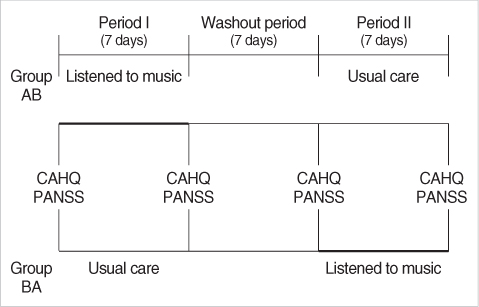
Figure & Data
REFERENCES
Citations

- Does Music Listening Affect Attention? A Literature Review
Camila Guimarães Mendes, Luiza Araújo Diniz, Débora Marques Miranda
Developmental Neuropsychology.2021; 46(3): 192. CrossRef - The Effect of Music on Auditory Hallucination and Quality of Life in Schizophrenic Patients: A Randomised Controlled Trial
Sükran Ertekin Pinar, Havva Tel
Issues in Mental Health Nursing.2019; 40(1): 50. CrossRef - Acute Effects of Music Therapy in Subjects With Psychosis During Inpatient Treatment
Umberto Volpe, Carlo Gianoglio, Luca Autiero, Maria Luisa Marino, Diana Facchini, Armida Mucci, Silvana Galderisi
Psychiatry.2018; 81(3): 218. CrossRef - The Necessity of Ambiguity in Self–Other Processing: A Psychosocial Perspective With Implications for Mental Health
Christophe Emmanuel de Bézenac, Rachel Ann Swindells, Rhiannon Corcoran
Frontiers in Psychology.2018;[Epub] CrossRef - Music therapy for people with schizophrenia and schizophrenia-like disorders
Monika Geretsegger, Karin A Mössler, Łucja Bieleninik, Xi-Jing Chen, Tor Olav Heldal, Christian Gold
Cochrane Database of Systematic Reviews.2017;[Epub] CrossRef - Perception of complexity, interest level, and preference for harmonic progression of music for adults with schizophrenia
Yoon Kyung Chung, Hyun Ju Chong, Soo Ji Kim
The Arts in Psychotherapy.2016; 48: 1. CrossRef - Musiktherapie & Neurologie
Wolfgang Mastnak
Musik-, Tanz- und Kunsttherapie.2015; 26(3): 123. CrossRef - Ambiguity between self and other: Individual differences in action attribution
Christophe E. de Bézenac, Vanessa Sluming, Noreen O’Sullivan, Rhiannon Corcoran
Consciousness and Cognition.2015; 35: 1. CrossRef - Artwork and music: Innovative approaches to physical assessment
Linda Honan Pellico, Kristopher Fennie, Stephanie Tillman, Thomas C. Duffy, Linda Friedlaender, Gillian Graham
Arts & Health.2014; 6(2): 162. CrossRef - The Effect of Group Music Therapy on the Social Function and Interpersonal Relationship in Outpatients with Schizophrenia
Hye-Jin Lee, Dae-Bo Lee, Min-Cheol Park, Sang-Yeol Lee
Journal of Korean Neuropsychiatric Association.2014; 53(1): 40. CrossRef - The use of tinnitus sound generators for auditory hallucinations
Rohul Amin, Candice E. Ortiz, Karen Parisien
Journal of Psychiatric Intensive Care.2014; 10(1): 57. CrossRef - The Effect of Group Music Therapy on the Social Function and Interpersonal Relationship in Outpatients with Schizophrenia
Hye-Jin Lee, Dae-Bo Lee, Min-Cheol Park, Sang-Yeol Lee
Journal of Korean Neuropsychiatric Association.2014; 53(1): 40. CrossRef - Music as a therapy: Role in psychiatry
Madhusudan Singh Solanki, Mehnaz Zafar, Rajesh Rastogi
Asian Journal of Psychiatry.2013; 6(3): 193. CrossRef - Effects of Group Music Therapy on Psychiatric Symptoms and Interpersonal Relationship in Patients with Schizophrenia
Yeong Sook Park, Yunhee Kwon
The Korean Journal of Rehabilitation Nursing.2012; 15(2): 126. CrossRef - The Effect of Listening to Music on Auditory Hallucination in Patients with Schizophrenia
Hye Jin Seo, Jung-Sun Lee, Chang Yoon Kim
Journal of Korean Neuropsychiatric Association.2012; 51(4): 202. CrossRef - Music Therapy on Anxiety, Stress and Maternal-fetal Attachment in Pregnant Women During Transvaginal Ultrasound
Hye Sook Shin, Ju Hee Kim
Asian Nursing Research.2011; 5(1): 19. CrossRef - Effect of Group Music Activity as an Adjunctive Therapy on Psychotic Symptoms in Patients With Acute Schizophrenia
Shu-Ming Peng, Malcolm Koo, Jen-Che Kuo
Archives of Psychiatric Nursing.2010; 24(6): 429. CrossRef

Figure 1
General Characteristics and Homogeneity Test between Two Groups
*Fisher's exact test.
Group AB=patients listened to music followed by usual care period; Group BA=patients had usual care period followed by listening to music.
Homogeneity of Research Variables between Two Groups
Group AB=patients listened to music followed by usual care period; Group BA=patients had usual care period followed by listening to music; CAHQ=The Characteristic of Auditory Hallucination Questionnaire; PANSS=Positive and Negative Syndrome Scale.
Comparison of Change in CAHQ between Two Groups
*p<.05.
Group AB=patients listened to music followed by usual care period; Group BA=patients had usual care period followed by listening to music; CAHQ=The Characteristic of Auditory Hallucination Questionnaire.
Comparison of Change in PANSS between Two Groups
*p<.05.
Group AB=patients listened to music followed by usual care period; Group BA=patients had usual care period followed by listening to music; PANSS=Positive and Negative Syndrome Scale.
*Fisher's exact test. Group AB=patients listened to music followed by usual care period; Group BA=patients had usual care period followed by listening to music.
Group AB=patients listened to music followed by usual care period; Group BA=patients had usual care period followed by listening to music; CAHQ=The Characteristic of Auditory Hallucination Questionnaire; PANSS=Positive and Negative Syndrome Scale.
*p<.05. Group AB=patients listened to music followed by usual care period; Group BA=patients had usual care period followed by listening to music; CAHQ=The Characteristic of Auditory Hallucination Questionnaire.
*p<.05. Group AB=patients listened to music followed by usual care period; Group BA=patients had usual care period followed by listening to music; PANSS=Positive and Negative Syndrome Scale.
 KSNS
KSNS
 E-SUBMISSION
E-SUBMISSION
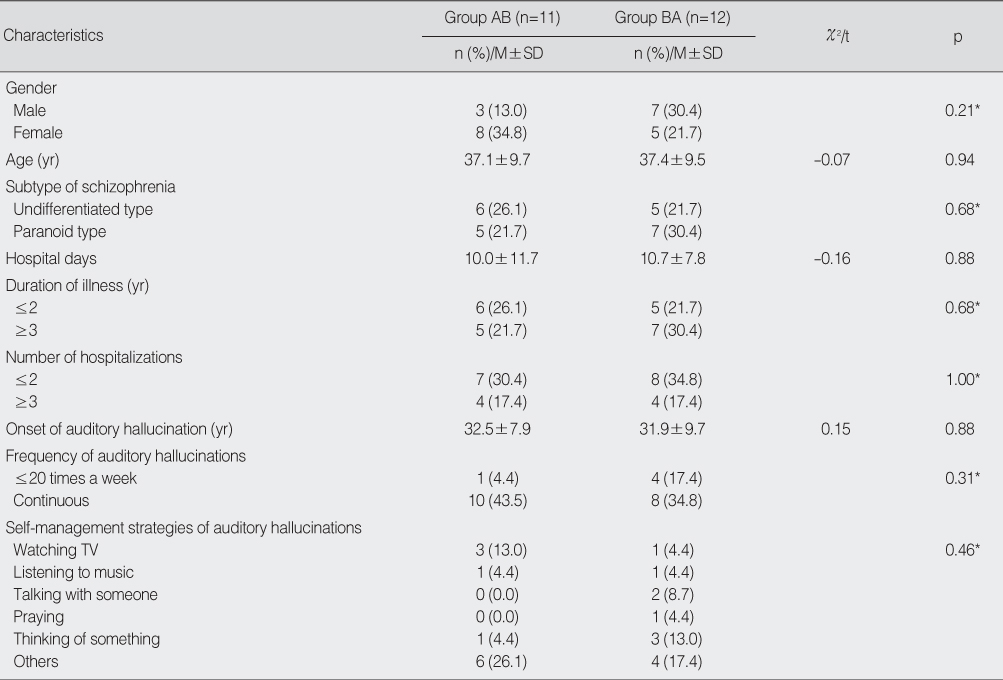
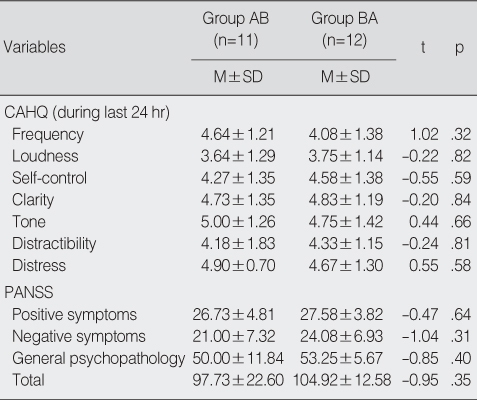
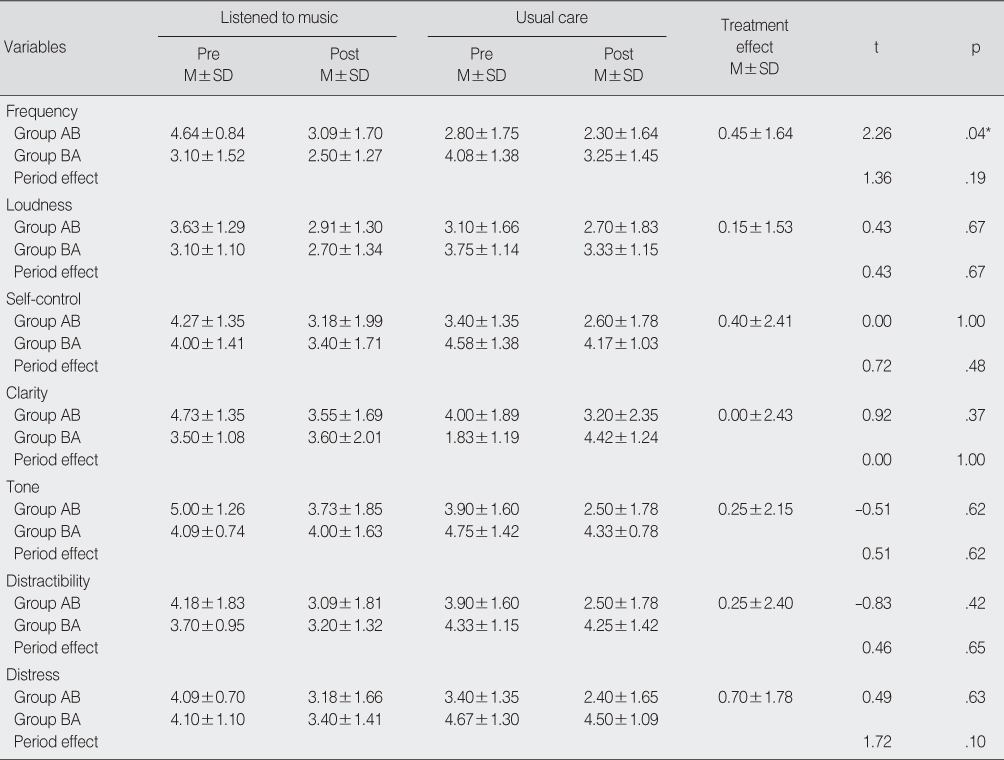
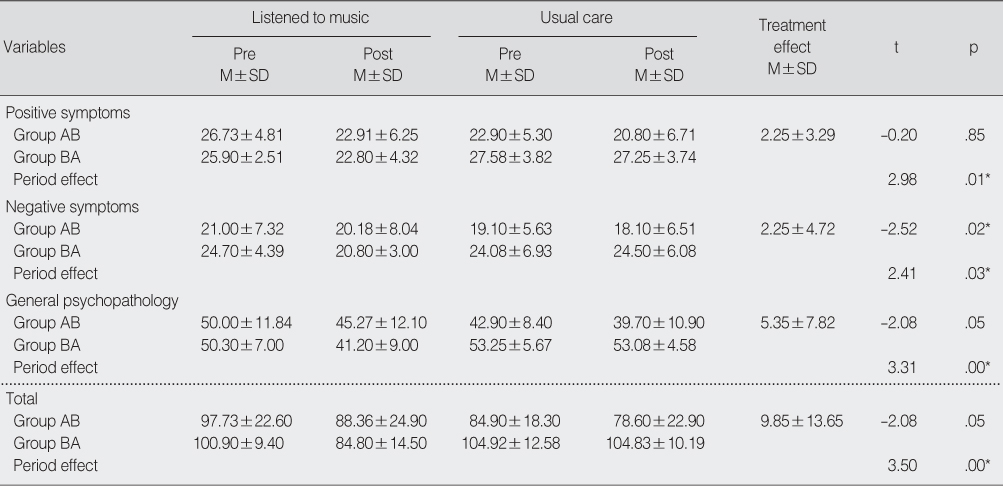
 Cite
Cite

